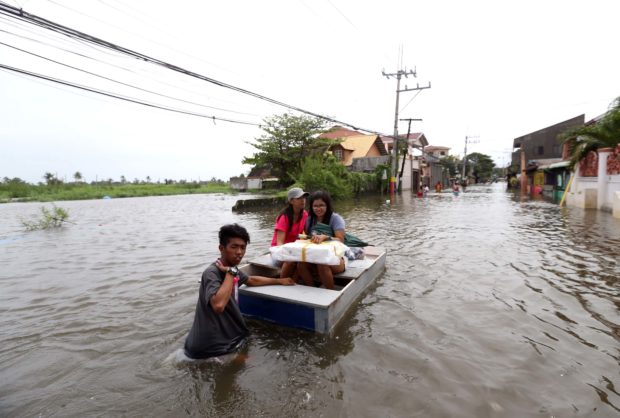
MODE OF TRANSPORT Residents of Barangay Panginay in Balagtas town, Bulacan province, use an improvised boat as means of transport as floodwaters still submerge their neighborhood. —LYN RILLON
Some 500 villages in Bulacan, Pampanga, Bataan, Nueva Ecija and Pangasinan were still flooded on Tuesday, as heavy rains persisted in Central Luzon, Cordillera Administrative Region and Ilocos.
Following the devastation wrought by the southwest monsoon, a state of calamity has been declared in four provinces and 29 towns and cities, the National Disaster Risk Reduction and Management Council (NDRRMC) said on Tuesday.
The NDRRMC said 22,000 families, or 100,000 people, had sought shelter in 253 evacuation centers in five regions.
Metro Manila is among the hardest hit, with 34,500 people still staying in 45 evacuation centers.
Displaced residents have not left evacuation centers in Malabon, Marikina, Mandaluyong, Manila, Navotas, Pasig, Quezon City, San Juan and Valenzuela, NDRRMC spokesperson Edgar Posadas told a press briefing on Tuesday.
Metro Manila experienced massive flooding due to heavy rains, which submerged and paralyzed many areas and led to class and work suspensions.
Since the Metro Manila flood control master plan was approved in 2012, only 14 percent of the P352 billion intended for the 23-year project has been allocated so far, according to the Department of Public Works and Highways (DPWH).
The master plan is intended to be completed by 2035 to reduce flooding in the metropolis. The 14 percent allocated already covers projects for 2019.
Houses damaged
The Disaster Risk Reduction and Management Council (DRRMC) in the Calabarzon (Cavite-Laguna-Batangas-Rizal-Quezon) said some local governments like those in Batangas and Cavite had allowed evacuees to return to their homes.
“But those in Rizal couldn’t go home yet because their houses were damaged by the flood and mud,” said the council’s information officer, Alex Masiglat.
Hardest-hit in the region was Rizal’s second district, particularly the towns of San Mateo (6,956 families affected) and Rodriguez (4,062 families).
Floodwaters in San Mateo rose to as high as 3 meters but subsided early Tuesday.
Evacuation along Agno
In Pangasinan, Gov. Amado Espino III ordered the forced evacuation of residents in “highly exposed and vulnerable” areas along the Agno River after San Roque Dam in San Manuel town discharged more water.
The river runs through the towns of San Manuel, San Nicolas, Tayug, Asingan, Santa. Maria, Rosales, Santo Tomas, Alcala, Bautista, Bayambang, Mangatrem, Urbiztondo, Aguilar, Bugallon, Lingayen and Labrador, and San Carlos City.
Odette Rivero, spokesperson for National Power Corp., said the dam’s floodgates would remain open until the reservoir reached 280 meters above sea level.
On Tuesday, 172 villages in 12 towns and cities of Pangasinan province were still flooded. A total of 938 families have been taken to evacuation centers.
So far, the flooded areas along the swollen Agno River were in the towns of Bautista, Bayambang, Aguilar, Villasis and Mangatarem and San Carlos.
The towns of Santa Barbara and Calasiao and Dagupan City remained submerged in up to 1.5 meters of water spilled from the Sinocalan River.
Classes in 26 towns and cities in the province were suspended on Tuesday.
Missing
Three people have been reported missing in the provinces of Benguet, Pangasinan and Nueva Ecija.
In the mining town of Mankayan, Benguet, a landslide struck near a footpath that was being cleared by residents.
No one was hurt, but rescuers were still searching for a certain Luvina Kidkid, 32.
In Central Luzon, 338 villages were flooded due to rain and high tide. These included 151 in Pampanga, 169 in Bulacan, 14 in Bataan and four in Nueva Ecija.
In Bulacan, 48 of 51 villages in the City of Malolos were submerged in nearly 1 meter of floodwater, while floods as high as 1.8 m affected most of Balagtas and Bocaue towns.
Ipo Dam continued to release 61.60 cubic meters per second of water as its reservoir breached its spilling level.
Bustos Dam reduced its water discharge from more than 500 cu m over the weekend to 290.
Damaged roads
The DPWH reminded motorists on Tuesday to steer clear of at least 16 roads in Luzon as these were still being fixed and cleared of debris.
In the Cordillera Administrative Region, nine roads were still closed to traffic. These are Kennon, Benguet-Nueva Vizcaya, Baguio-Bontoc, Abra-Ilocos Norte, Abra-Kalinga, Baguio City Limit-Santo Tomas, Acop-Kapangan-Kibungan-Bakun, Gurel-Bokod-Kabayan-Buguias-Abatan and Tabuk-Banaue Roads.
In Central Luzon, six roads remained impassable. These are Bigaa Plaridel via Bulacan and Malolos, Santo Tomas-Minalin (Minalin-Macabebe Section), Baliwag-Candaba-Santa Ana, Bomba Bridge, Apalit-Macabebe-Masantol, Candaba-San Miguel Road, and Paniqui-Camiling-Wawa Roads.
Pangasinan’s Calasiao Old Road is still being cleared of debris. —Reports from Jeannette I. Andrade, Leila B. Salaverria, Jovic Yee, Gabriel Cardinoza, Yolanda Sotelo, Armand Galang, Tonette Orejas, Carmela Reyes-Estrope and Maricar Cinco